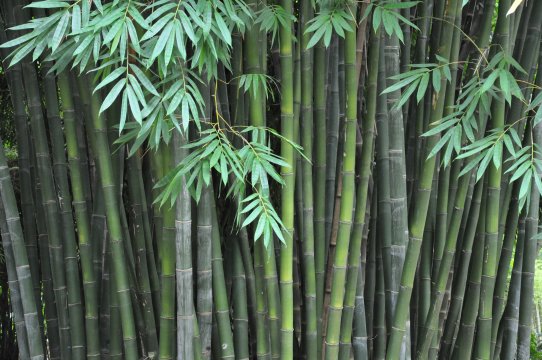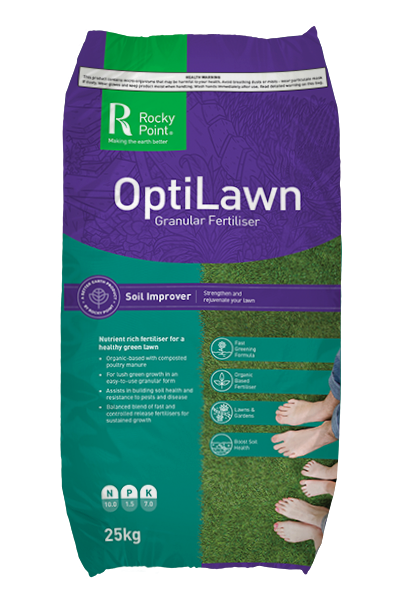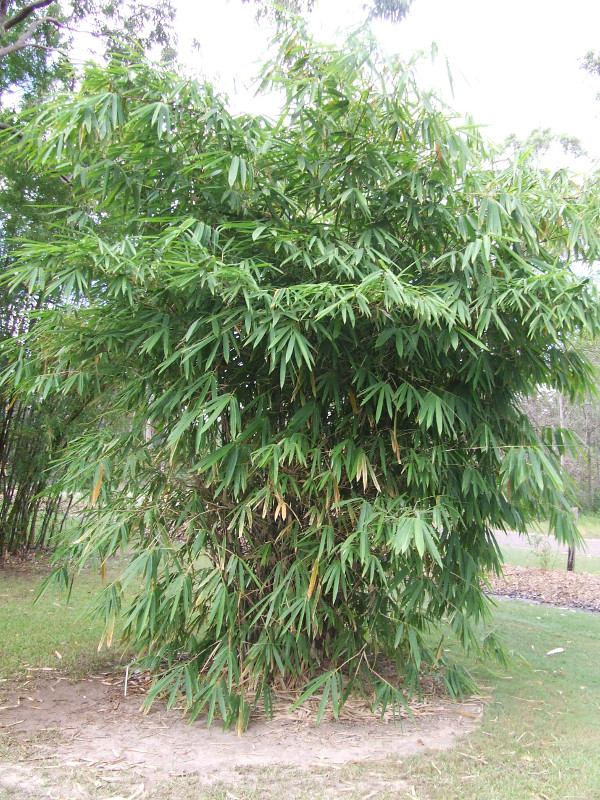Soil requirements
Bamboo will grow in most soil types, whether it be clay-based soil or sand. They have a very shallow root system (about 30cm for smaller bamboos and about 50cm for larger ones), thus the type of soil is not all that important (though good top soil obviously helps). What is important rather, is 'feeding' the bamboo on-top of the soil with a good thick mulch layer and regular fertilising.
Most bamboos like reasonably well drained soil and they don't like to be growing in swampy areas or areas that get inundated with water for longer periods of time.
Receiving the bamboo plants
Once you have gotten your bamboo home, or once they have been delivered to your property, they should preferably be planted immediately. If you are not ready to plant right away, then place them in a slightly shaded location away from high winds. The plants may have been in transit for a few days without water, so make sure you give them a really good soaking. If the leaves are wilted and rolled up, then its a pretty clear sign that they desperately need water.
There are various stages of water stress; the first being leaf curl where a thorough watering will generally unfurl the leaves within an hour or two without any damage to the plant. The next stage would be that the root ball has been sufficiently dry to do permanent damage to the leaves; leaves will turn yellow or leaf tips will turn brown. This damage to the leaves is irreparable but as long as the bamboo gets proper watering, then the bamboo will recover without any long term effects to the bamboo - damaged leaves may fall off, but will be replaced by new leaves within a few weeks. The 3rd stage really is if the root balls have dried out completely for an extended period of time - all leaves will fall off, culms will dry out completely and will not generate new side branches or foliage. The plant may die if its gets to this stage. Cutting the tops off the bamboo to reduce water loss can help, and if lucky, the bamboo can still recover by growing new shoots from the ground - albeit overall growth performance will be set back.
Planting
Dig hole twice as wide as the diameter of the pot/planter bag and to about the same depth as the pot/bag. There is little need to dig deep holes due to the shallow rooted nature of bamboo - roots will want to grow out horizontally, rather than downwards. Any improvements to the soil are therefore best focused on the topsoil.
Improving poor soils by digging in manures, compost, mushroom compost, or garden soil will ensure the bamboo is off to a good start.
Clay soils may need to be broken up a bit with some good compost or organic matter worked into it. Use Dolomite or Gypsum to break up any particularly hard clay soils.
Very sandy soils will benefit from adding compost or heavier garden soils to improve the water holding capacity of the soil.
Most of our bamboos are sold in plastic planter bags. The best way to remove the bags is to cut the bag open and pull off. The roots should NOT be teased out - teasing the roots will just cause damage to the root system.
Back fill the soil around the root ball and then give a really good flooding with water. The water will cause the loose soil around the root ball to settle, removing any air pockets around the roots. This step is VITAL. Poorly backfilled soil or air pockets around the root ball can cause the root balls to dry out and cause stress to the bamboo.
There is no need to mound up the soil around the plant so just plant it at ground level, leaving a bit of a moat around it to collect water. The exception to this is if the area where you are planting is wet, swampy or heavy clay soils, in which case its a good idea to mound up the area around where you are planting so as to avoid water logging.
Sometimes, the bamboo plants that we sell can be fairly tall and culms may not remain perfectly upright after planting and exposed to wind. This is nothing to worry about as the original culms (stems) and foliage that is on the plant at time of purchase is not going to grow anymore, rather new growth is going to be from new shoots growing from the ground up. You can put a stake in the ground and tie the bamboo to it if you want to, but this would be more for just visual appearance rather than out of necessity.
Planting bamboo can be done any time of year, with the exception being if you are in an area with heavy frosts, in which case its best not to plant during winter. Planting in Spring and Summer will produce very quick visible results - since its the main growth period of the bamboo. Since growth is much quicker during Spring and Summer, the time it takes for the bamboo plants to get established is much shorter during this period. Spring and Summer is therefore the ideal time to plant. Planting during winter is also possible, but you just have to be a bit more patient - the bamboo plants will still be growing roots and getting established but visible above-ground growth will be quite minimal. As soon as Spring arrives along with the warmer temperatures, the bamboo will start growing new side branches and foliage from existing culms, which is then followed up by new shoots coming up from the ground.
Watering
Following the planting of bamboo, it is crucial that they be well watered for the first month or two, by this we mean a good deep soaking every couple of days. If planting in the middle of summer, and ground is dry, daily watering may be required. Once they are established (after a couple of months), watering requirements become less stringent. It is important to realise that it takes time fo the bamboo roots to ground out into surrounding soil, so water should be concentrated directly on the root ball. Roots will grow out quickly during summer, but quite slowly during winter. Bamboo plants (once established) are very hardy and will not die if left unwatered, though having said this, they do like a regular watering and will definitely give more rewarding results if watered on a regular basis.
Don't be fooled by thinking just because you have an automatic irrigation system set up, that the newly planted bamboo is getting enough water. Check daily whether there is any signs of wilting foliage. If there are any signs of dry plants, then remove mulch and dig down the side of the rootball to see how far the water has made it down. If the bottom of the root ball is still dry, then increase your watering time or amount of water applied. Drippers directly onto each rootball are alright to use for the first few months after planting, but as the bamboo roots grow out, you want to actually water the entire ground area around the bamboo which is best done with above ground sprinklers. Even from the start, above ground sprinklers are best as it wets the entire topsoil area, which encourages roots to grow outwards from the initial root ball.
Bamboo thrives if watered with grey water (household wastewater) or growing on top of infiltration beds or areas utilising pump-out soaker systems.
Mulching
As mentioned above, bamboo loves a good mulch layer - 50 to 100mm deep. By mulching the soil around the bamboo, you're doing 3 things:
- Reducing moisture loss
- Providing organic matter to the plant (which decomposes and 'feeds' the bamboo).
- Preventing grass / weeds from growing up around the plant.
The best types of mulch is basically anything organic that can decompose to enrich the soil and thus providing the bamboo with nutrients. Raking up leaves around the plants is a good start. Some other options are sugar cane mulch, hay or straw. Even green grass clippings will do the trick if composted a bit first, or spread thinly around the bamboo.
Don't worry about keeping the mulch away from the stems of the bamboo (as is the case with trees) - this does not affect bamboo. New shoots emerging from the ground will find their way through the mulch layer.
Fertilising
Bamboo loves nitrogen - all grasses do, and afterall, bamboo is a type of grass.
At Bamboo Land, the fertiliser we use is on all our bamboo is Rocky Point's OptiLawn. Other fertilisers like Katek SuperGrass and Incitec Pivot CK88 (Crop King 88) are also suitable. Basically, any fertiliser that is good for lawns, grasses, palms, etc will be good for bamboo. The OptiLawn and SuperGrass are organic blends with added nitrogen.
These fertilisers include granular nitrogen which means that they should be spread on top of the soil and then watered in (ie. top dress applications). They should not be used in the hole when planting, as they may damage the roots.
When planting our smaller sized bamboo plants, use equivalent of a heaped tablespoon of fertiliser on each newly planted bamboo - spread within a radius of about a foot from the plant (this encourages roots to grow outwards).
For mature clumps of bamboo, you may apply 5 to 10 hand fulls around each clump (1 to 2 meter radius from the clump).
The times to add fertiliser is directly after planting and during the main growth season. The main growth occurs between November to April, thus fertilising around September or October gets them off to a good start for the year, and then you can fertilise again every one or two months up to about April.
Organic fertilisers like Blood-and-Bone, Dynamic Lifter, seaweed fertiliser or manures are all ok to use but will still benefit from additional nitrogen.
Clump Maintenance
Bamboo, like most plants, does need a bit of TLC for it to look its best. A few years after planting a bamboo, the older culms within the clump will start dying, possibly giving the clump an untidy appearance. It is at this stage that that its time to get crafty with the old pruning saw and secateurs. A quick half-hour will leave your bamboo looking refreshed and looking the way it was intended. It is up to the gardener as to how much should be cut out of the clump. In some situations, it may be desired that the clump be as bushy as possible (for screening purposes) in which case you would cut out very little. In other situations, it may be a more sparse look that is sought after, in which case a lot can be cut out leaving only one years shoots remaining. This sort of thinning out of the clumps should be carried out yearly and is best done during winter. Winter is the best time to do this since that's when there are no new soft shoots within the clump that could be damaged during the process.
A simple pull-action pruning saw is the best to cut out culms (at ground level) from a clump as it is easy to get in-between culms to cut out plant material from the centre of the clumps. Branches are best cut off with secateurs. If you need tools, check out our Japanese tool range. If it's a big bamboo that you're dealing with, then a chainsaw may be the answer to make work a little easier.





.jpg)